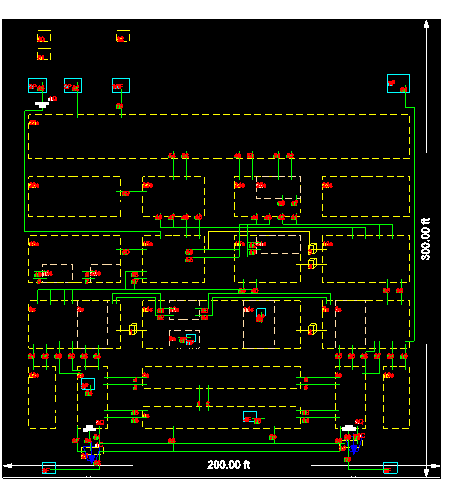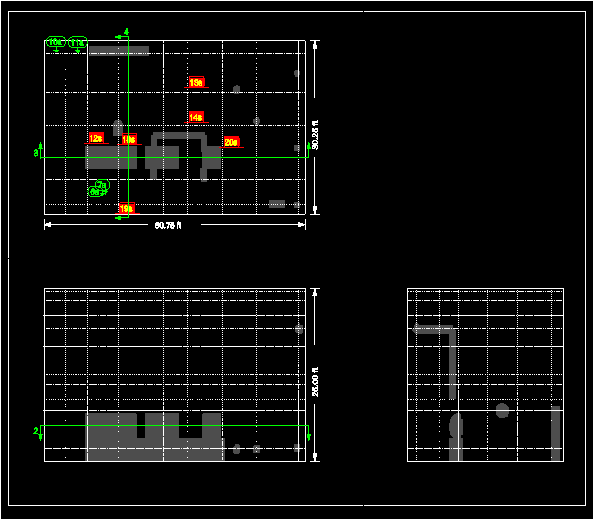Red Wolf Associates can provide modeling and analysis services to determine thermal response in individual rooms or an entire building at nuclear power plants. Steady-state as well as transient analyses for normal operation, accidents, and loss of HVAC can be completed with GOTHIC™ or other codes and methods. Rooms of interest can be modeled in as much or little detail as required by the objectives of the analysis. Models can be as simple as a single node volume to represent a room for screening purposes or steady-state analyses or as complex as a full three-dimensional representation of the room geometry with realistic modeling of radiation heat transfer, motor heat up, and other critical phenomena.
Red Wolf Associates staff members have wide-ranging experience with room/building thermal response models for both PWR and BWR plants. Previously completed analyses performed by our personnel include GOTHIC™ models for:
|
|
Classical Room Heat Up and HVAC Analysis
Traditional lumped or coarsely divided models often are used to evaluate the thermal response of individual rooms. This is a more cost effective approach than a detailed three-dimensional model and usually yields satisfactory results. Even when modeling individual rooms with single volumes, natural circulation between the rooms can be credited in GOTHIC with proper modeling techniques. This allows the user to build simplified models that can be used effectively when a more detailed model is unwarranted.
Typically each modeled compartment may be represented with a single volume. Adjacent areas are modeled with other volumes or thermal and heat structure boundary conditions as needed. Heat from piping, motors, electrical equipment, cables, lighting and other sources can be applied using the most appropriate modeling method. Doors between rooms are modeled so that potential operator actions for event mitigation can be assessed. Other openings between rooms including pipe penetrations, fire dampers, HVAC ductwork, etc. are often modeled explicitly. Depending on the flow characteristics of the building, HVAC ductwork is typically modeled so that appropriate natural circulation flows between rooms are accounted for if HVAC fans are assumed to fail. Heat sinks are also appropriately included in the model. In some cases, fan cooler cooling coils may be modeled explicitly to assess the impact of water temperatures and flow rates through the coils. Similar methods also may be used to model heat transfer from RHR and other process heat exchangers.
Red Wolf Associates staff has implemented detailed modeling of critical model inputs to obtain acceptable results for some analyses. For example, in diesel generator room heat-up analyses the diesel engine itself has been modeled such that the thermal mass of the engine is credited. This technique can be benchmarked against test data to ensure a conservative result and maximize the time for operator action to mitigate the room temperature response. In other applications, the seldom-used radiation heat transfer option in GOTHIC™ has been used to model heat transfer from containment ventilation system ductwork. This allows calculation of an appropriate combined heat transfer from convection and radiation rather than using an overly conservative, bounding value from a typical engineering reference, helping to provide a more realistic temperature response in the modeled area.
Detailed GOTHIC™ Modeling
A typical room heat-up analysis that provides an average temperature for an entire room or compartment is not appropriate for some applications. The temperature surrounding vulnerable components can differ significantly from the average room temperature depending on the location of the equipment and heat sources. Measured spatial temperature differences of greater than 10°F have been observed in small ECCS pump rooms during some scenarios. If these differences require evaluation, a multi-dimensional model may be necessary to ensure equipment operability.
 Red Wolf Associates personnel have extensive experience modeling rooms and buildings in three dimensions using GOTHIC™. These analyses have been completed to support environmental qualification of equipment, operator actions for Appendix R, and operability determinations, among others. Often times these models are benchmarked to test data to validate the model. Benchmarking the models typically requires advanced techniques such as thermal lagging of process equipment/piping heat loads, crediting of non-typical heat sinks such as liquid filled tanks and metal mass, and consideration of surface-to-surface radiation. The past experience of our personnel with implementing these techniques and our understanding of the underlying assumptions and methods used in GOTHIC™ ensure that the most accurate result possible is provided to our clients.
Red Wolf Associates personnel have extensive experience modeling rooms and buildings in three dimensions using GOTHIC™. These analyses have been completed to support environmental qualification of equipment, operator actions for Appendix R, and operability determinations, among others. Often times these models are benchmarked to test data to validate the model. Benchmarking the models typically requires advanced techniques such as thermal lagging of process equipment/piping heat loads, crediting of non-typical heat sinks such as liquid filled tanks and metal mass, and consideration of surface-to-surface radiation. The past experience of our personnel with implementing these techniques and our understanding of the underlying assumptions and methods used in GOTHIC™ ensure that the most accurate result possible is provided to our clients.

